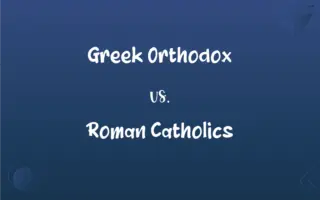Many vs. Most: What's the Difference?
Edited by Janet White || By Harlon Moss || Published on March 5, 2024
Many refers to a large number of items or people. Most indicates the greatest in number or the majority of items or people.

Key Differences
Many implies a large number, but without a specific quantification. It is used when referring to a significant portion of a group but not necessarily the majority. Most, in contrast, specifically refers to the majority or the largest part of a group. It denotes more than half of the total number.
Many is often used to describe a considerable quantity within a larger set, without suggesting that it is the largest subset. For instance, "many people enjoy music" suggests a large group but not necessarily the majority. Most, however, conveys a sense of the largest part or majority, as in "most people enjoy music," implying that more than half do.
When using many, it's about quantity without surpassing the halfway mark of a total. It's qualitative rather than quantitative. On the other hand, most is quantitative, indicating the highest number in comparison to other segments within the whole.
In usage, many can be replaced with words like 'numerous' or 'various', emphasizing diversity or abundance without numerical dominance. Most, however, aligns with words like 'majority' or 'largest portion', clearly indicating numerical superiority within a group.
When considering grammar, many is used with countable nouns, while most can be used with both countable and uncountable nouns, further distinguishing their applications. Most also serves as a superlative form, unlike many.
ADVERTISEMENT
Comparison Chart
Quantity
Large but undefined
Majority or largest portion
Usage with Nouns
Primarily with countable
Both countable and uncountable
Implication
Significant portion, not majority
More than half, majority
Grammatical Role
Quantifier
Quantifier and superlative
Synonyms
Numerous, various
Majority, largest part
ADVERTISEMENT
Many and Most Definitions
Many
A large number of.
Many students attended the lecture.
Most
The greatest in number.
Most people agree with this opinion.
Many
A considerable amount.
Many opportunities are available in the city.
Most
Nearly all of.
Most of the cake was eaten.
Many
Various, numerous.
She has visited many countries.
Most
The largest part.
Most of the island is uninhabited.
Many
A significant portion of a group.
Many people prefer coffee over tea.
Most
The majority of.
Most of the work is already done.
Many
A multitude of.
Many stars are visible in the night sky.
Most
Almost all.
Most days, he walks to work.
Many
Amounting to or consisting of a large indefinite number
Many friends.
Most
Greatest in number
Won the most votes.
Many
Being one of a large indefinite number; numerous
Many a child.
Many another day.
Most
Greatest in amount, extent, or degree
Has the most compassion.
FAQs
Is "most" always a superlative?
Yes, it often acts as a superlative, indicating the highest in number.
Is "most" appropriate for indicating the largest part of something uncountable?
Yes, it can be used for both countable and uncountable nouns.
Can "many" imply a majority?
No, "many" suggests a large number but not necessarily a majority.
Can "most" be used without a following noun?
Yes, it can stand alone as in "Most agree."
Can "many" be used with uncountable nouns?
No, "many" is used with countable nouns.
Is "most" used in comparative structures?
No, "most" is used in superlative structures.
Can "many" indicate a specific number?
No, "many" refers to a large but unspecified number.
Can "many" be used in a comparative sense?
No, "many" is not used in comparative or superlative forms.
Does "many" have a superlative form?
No, it does not function in a superlative capacity.
Are there exceptions to using "many" with only countable nouns?
Generally, no; it's primarily used with countable nouns.
Can "many" and "most" be used interchangeably?
No, they have different meanings and usages.
Does "most" require a comparative context?
No, it stands alone to denote the majority.
Can "many" be used to emphasize diversity?
Yes, it can emphasize a variety within a group.
Is "most" suitable for emphasizing a large but non-majority portion?
No, it specifically denotes the majority or largest part.
Does "most" always mean more than half?
Yes, it typically implies more than half or the majority.
Can "most" refer to quality?
No, it primarily quantifies quantity, not quality.
Is "many" a quantitative or qualitative descriptor?
It is more qualitative, indicating diversity or abundance.
Does "many" ever mean all?
No, it never encompasses the entirety of a group.
Is "most" applicable when talking about a total group?
Yes, it refers to the largest portion of a group or total.
Is "most" appropriate for exact numerical quantification?
No, it indicates a general majority without specific numbers.
About Author
Written by
Harlon MossHarlon is a seasoned quality moderator and accomplished content writer for Difference Wiki. An alumnus of the prestigious University of California, he earned his degree in Computer Science. Leveraging his academic background, Harlon brings a meticulous and informed perspective to his work, ensuring content accuracy and excellence.
Edited by
Janet WhiteJanet White has been an esteemed writer and blogger for Difference Wiki. Holding a Master's degree in Science and Medical Journalism from the prestigious Boston University, she has consistently demonstrated her expertise and passion for her field. When she's not immersed in her work, Janet relishes her time exercising, delving into a good book, and cherishing moments with friends and family.







































































